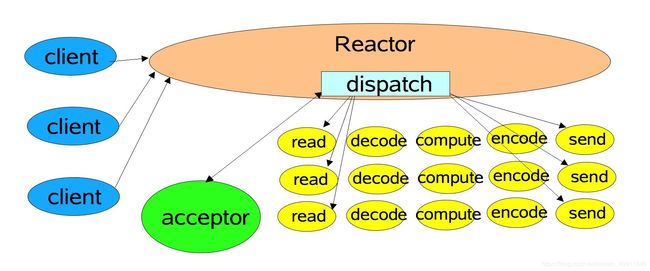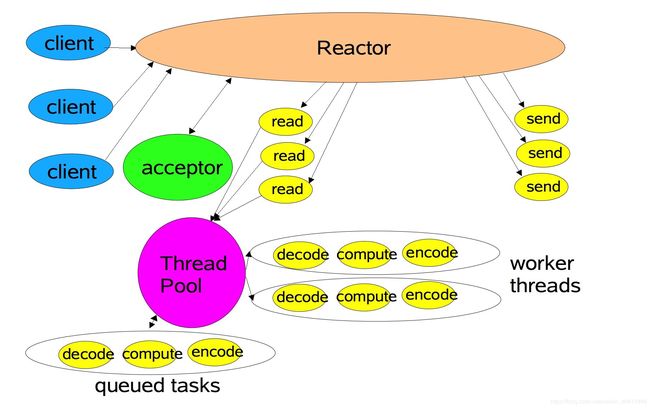基于Netty的WebSocket聊天室Demo
基于Netty的WebSocket聊天室Demo
这个项目基于Netty 4.1.x、Spring Boot、Spring WebFlux,构建了一个基于WebSocket协议的多人聊天室Demo。这个项目能够帮助我们快速学习、了解Netty和WebSocket。
核心依赖
用途在代码中注明了。
<dependencies>
<dependency>
<groupId>org.springframework.bootgroupId>
<artifactId>spring-boot-starter-thymeleafartifactId>
dependency>
<dependency>
<groupId>org.springframework.bootgroupId>
<artifactId>spring-boot-starter-webfluxartifactId>
dependency>
<dependency>
<groupId>io.nettygroupId>
<artifactId>netty-allartifactId>
<version>4.1.41.Finalversion>
dependency>
dependencies>
Web部分
既然聊天室是用Netty搭的,为什么Web不用Netty呢?所以就用Spring WebFlux替代了Spring Web MVC。
在这个过程中,碰到了WebFlux无法正确集成Thymeleaf的问题,WebFlux的视图解析viewResolvers需要手动地添加。解决如下:https://blog.csdn.net/fly_leopard/article/details/88355349
负责配置WebFlux的WebFluxConfig.java如下。它为WebFlux注册了视图解析器(Thymeleaf的),@EnableWebFlux正式开启了WebFlux。
package top.spencercjh.chatdemo.controller;
// 省略import
/**
* @author Spencer
* reference: https://blog.csdn.net/fly_leopard/article/details/88355349
*/
@Configuration
@EnableWebFlux
public class WebFluxConfig implements WebFluxConfigurer {
/**
* 引入spring-boot-starter-thymeleaf自动会注入该bean
*/
@Autowired
private ThymeleafReactiveViewResolver thymeleafReactiveViewResolver;
/**
* 加入thymeleaf试图解析器,不然找不到view name
* @param registry webflux view registry
*/
@Override
public void configureViewResolvers(ViewResolverRegistry registry) {
registry.viewResolver(thymeleafReactiveViewResolver);
}
/**
* 映射静态资源文件映射
* @param registry webflux resource registry
*/
@Override
public void addResourceHandlers(ResourceHandlerRegistry registry) {
registry.addResourceHandler("/static/**")
//指向的是目录
.addResourceLocations("classpath:/static/");
}
}
负责具体页面的PageController.java如下。它非常简单,只是做2个返回HTML视图的Get请求。
package top.spencercjh.chatdemo.controller;
// 省略import
/**
* @author Spencer
*/
@Controller
public class PageController {
@GetMapping("/chat")
public String chat() {
return "chat";
}
@GetMapping("/index")
public String index() {
return "index";
}
}
Netty部分
Netty的主体框架都在Netty.java中。
package top.spencercjh.chatdemo.netty;
// 省略import
/**
* @author Spencer
*/
@Component
public class Netty {
/**
* 存储所有连接的 channel
*/
final static ChannelGroup CHANNEL_GROUP = new DefaultChannelGroup(GlobalEventExecutor.INSTANCE);
public static String WS_HOST;
public static int WS_PORT;
private final EventLoopGroup bossGroup = new NioEventLoopGroup();
private final EventLoopGroup workGroup = new NioEventLoopGroup();
private Channel channel;
/**
* spring boot 不允许/不支持把值注入到静态变量中 所以采用 setter 的方式注入
*/
@Value("${netty.host}")
public void setWebSocketHost(String host) {
WS_HOST = host;
}
@Value("${netty.port}")
public void setWebSocketPort(int port) {
WS_PORT = port;
}
public ChannelFuture start(InetSocketAddress address) {
ServerBootstrap bootstrap = new ServerBootstrap();
bootstrap.group(bossGroup, workGroup)
.channel(NioServerSocketChannel.class)
.childHandler(new ServerInitializer())
.option(ChannelOption.SO_BACKLOG, 128)
.childOption(ChannelOption.SO_KEEPALIVE, true);
ChannelFuture future = bootstrap.bind(address).syncUninterruptibly();
channel = future.channel();
return future;
}
public void destroy() {
if (channel != null) {
channel.close();
}
Netty.CHANNEL_GROUP.close();
workGroup.shutdownGracefully();
bossGroup.shutdownGracefully();
}
static class ServerInitializer extends ChannelInitializer<Channel> {
@Override
protected void initChannel(Channel channel) {
ChannelPipeline pipeline = channel.pipeline();
pipeline.addLast("http-codec", new HttpServerCodec());
pipeline.addLast("aggregator", new HttpObjectAggregator(65536));
pipeline.addLast("http-chunked", new ChunkedWriteHandler());
pipeline.addLast("handler", new WebSocketHandler());
}
}
}
ServerBootstrap Netty的核心配置
最重要的是启动Netty服务器:
public class Netty {
//省略其他代码
private final EventLoopGroup bossGroup = new NioEventLoopGroup();
private final EventLoopGroup workGroup = new NioEventLoopGroup();
private Channel channel;
public ChannelFuture start(InetSocketAddress address) {
ServerBootstrap bootstrap = new ServerBootstrap();
bootstrap.group(bossGroup, workGroup)
.channel(NioServerSocketChannel.class)
.childHandler(new ServerInitializer())
.option(ChannelOption.SO_BACKLOG, 128)
.childOption(ChannelOption.SO_KEEPALIVE, true);
ChannelFuture future = bootstrap.bind(address).syncUninterruptibly();
channel = future.channel();
return future;
}
//省略其他代码
}
BossEventLoopGroup是Main Reactor,其通过事件循环创建TCP连接,然后将连接的SocketChannel抽象绑定到WorkEventLoopGroup中的EventLoop,形成Sub Reactor。
Main Reactor是单线程的事件循环。虽然也可以构造多线程,但是没有意义。因为Netty中在绑定端口时,只会使用EventLoopGroup中的一个EventLoop绑定到NIO中的Selector上,即使是使用了EventLoopGroup。
对于同个应用,如果监听多个端口,使用多个ServerBootstrap共享一个BossEventLoopGroup。这样Main Reactor也是多线程模式了,才有多线程的意义。
这里我这样写bootstrap.group(bossGroup, workGroup),就表明使用了2个EventLoopGroup,这是Netty里声明“多Reactor模式”的体现。
channel(NioServerSocketChannel.class) Socket连接
childHandler(new ServerInitializer()) 监听Channel,为channel中的pipeline添加各种handler。
Handler和childHandler的区别如下:https://www.jianshu.com/p/da4d2b5e34ee
ServerInitializer
ServerInitializer是静态内部类,初始化Channel,为channel的pipeLine添加Handler。其中HttpServerCodec是Netty的对HTTP协议的解码handler,HttpObjectAggregator是Netty对分块请求的重新聚合Handler,ChunkedWriteHandler是Netty分块写返回数据的Handler,WebSocketHandler是我们自己实现的对这个应用中WebSocket消息的解析Handler。
ServerInitializer
ServerInitializer是静态内部类,初始化Channel,为channel的pipeLine添加Handler。其中HttpServerCodec是Netty的对HTTP协议的解码handler,HttpObjectAggregator是Netty对分块请求的重新聚合Handler,ChunkedWriteHandler是Netty分块写返回数据的Handler,WebSocketHandler是我们自己实现的对这个应用中WebSocket消息的解析Handler。
public class Netty {
//省略其他代码
static class ServerInitializer extends ChannelInitializer<Channel> {
@Override
protected void initChannel(Channel channel) {
ChannelPipeline pipeline = channel.pipeline();
pipeline.addLast("http-codec", new HttpServerCodec());
pipeline.addLast("aggregator", new HttpObjectAggregator(65536));
pipeline.addLast("http-chunked", new ChunkedWriteHandler());
pipeline.addLast("handler", new WebSocketHandler());
}
}
//省略其他代码
}
WebSocketHandler 业务的具体实现
WebSocketHandler的具体实现如下WebSocketHandler.java。
package top.spencercjh.chatdemo.netty;
// 省略import
/**
* @author spencercjh
*/
public class WebSocketHandler extends SimpleChannelInboundHandler<Object> {
private static final Logger logger = LoggerFactory.getLogger(WebSocketHandler.class);
private final Gson gson = new Gson();
private WebSocketServerHandshaker handShaker;
/**
* 消息读取
* @param ctx ChannelHandlerContext
* @param msg WebSocketFrame or HTTP Request
*/
@Override
protected void channelRead0(ChannelHandlerContext ctx, Object msg) {
if (msg instanceof FullHttpRequest) {
handleHttpRequest(ctx, (FullHttpRequest) msg);
} else if (msg instanceof WebSocketFrame) {
handleWebSocketMessage(ctx, (WebSocketFrame) msg);
}
}
/**
* on open
* Invoked when a Channel is active; the Channel is connected/bound and ready.
* 当连接打开时,这里表示有数据将要进站。
*/
@Override
public void channelActive(ChannelHandlerContext ctx) {
Netty.CHANNEL_GROUP.add(ctx.channel());
}
/**
* on close
* Invoked when a Channel leaves active state and is no longer connected to its remote peer.
* 当连接要关闭时
*/
@Override
public void channelInactive(ChannelHandlerContext ctx) {
broadcastWsMsg(ctx, new WebSocketMessage(-11000, ctx.channel().id().toString()));
Netty.CHANNEL_GROUP.remove(ctx.channel());
}
/**
* on msg over
* Invoked when a read operation on the Channel has completed.
*/
@Override
public void channelReadComplete(ChannelHandlerContext ctx) {
ctx.flush();
}
/**
* onerror
* 发生异常时
*/
@Override
public void exceptionCaught(ChannelHandlerContext ctx, Throwable cause) {
cause.printStackTrace();
ctx.close();
}
/**
* 集中处理 ws 中的消息
*/
private void handleWebSocketMessage(ChannelHandlerContext ctx, WebSocketFrame msg) {
if (msg instanceof CloseWebSocketFrame) {
// 关闭指令
handShaker.close(ctx.channel(), (CloseWebSocketFrame) msg.retain());
}
if (msg instanceof PingWebSocketFrame) {
// ping 消息
ctx.channel().write(new PongWebSocketFrame(msg.content().retain()));
} else if (msg instanceof TextWebSocketFrame) {
TextWebSocketFrame message = (TextWebSocketFrame) msg;
// 文本消息
WebSocketMessage webSocketmessage = gson.fromJson(message.text(), WebSocketMessage.class);
logger.info("接收到消息:" + webSocketmessage);
switch (webSocketmessage.getType()) {
// 进入房间
case 1:
// 给进入的房间的用户响应一个欢迎消息,向其他用户广播一个有人进来的消息
broadcastWsMsg(ctx, new WebSocketMessage(WebSocketMessage.ENTER_MSG_TYPE, webSocketmessage.getName()));
AttributeKey<String> name;
if (AttributeKey.exists(webSocketmessage.getName())) {
name = AttributeKey.valueOf(webSocketmessage.getName());
} else {
name = AttributeKey.newInstance(webSocketmessage.getName());
}
ctx.channel().attr(name);
ctx.channel().writeAndFlush(new TextWebSocketFrame(
gson.toJson(new WebSocketMessage(WebSocketMessage.WELCOME_MSG_TYPE, webSocketmessage.getName()))));
break;
// 发送消息
case 2:
// 广播消息
broadcastWsMsg(ctx, new WebSocketMessage(
WebSocketMessage.NORMAL_MSG_TYPE, webSocketmessage.getName(), webSocketmessage.getBody()));
break;
// 离开房间.
case 3:
broadcastWsMsg(ctx, new WebSocketMessage(
WebSocketMessage.LEAVE_MSG_TYPE, webSocketmessage.getName(), webSocketmessage.getBody()));
break;
default:
break;
}
Netty.CHANNEL_GROUP.writeAndFlush(new TextWebSocketFrame(new Date().toString()));
}
}
/**
* 处理 http 请求,WebSocket 初始握手 (opening handshake ) 都始于一个 HTTP 请求
*/
private void handleHttpRequest(ChannelHandlerContext ctx, FullHttpRequest fullHttpRequest) {
if (!fullHttpRequest.decoderResult().isSuccess() || !(WebSocketMessage.HEADER_WEBSOCKET.contentEquals(
fullHttpRequest.headers().get(WebSocketMessage.HEADER_UPGRADE)))) {
sendHttpResponse(ctx, new DefaultFullHttpResponse(HttpVersion.HTTP_1_1, HttpResponseStatus.BAD_REQUEST));
return;
}
WebSocketServerHandshakerFactory factory = new WebSocketServerHandshakerFactory(
"ws://" + Netty.WS_HOST + Netty.WS_PORT, null, false);
handShaker = factory.newHandshaker(fullHttpRequest);
if (handShaker == null) {
WebSocketServerHandshakerFactory.sendUnsupportedVersionResponse(ctx.channel());
} else {
handShaker.handshake(ctx.channel(), fullHttpRequest);
}
}
/**
* 响应非 WebSocket 初始握手请求
*/
private void sendHttpResponse(ChannelHandlerContext ctx, DefaultFullHttpResponse res) {
if (HttpStatus.OK.value() != res.status().code()) {
ByteBuf buf = Unpooled.copiedBuffer(res.status().toString(), CharsetUtil.UTF_8);
res.content().writeBytes(buf);
buf.release();
}
ChannelFuture channelFuture = ctx.channel().writeAndFlush(res);
if (HttpStatus.OK.value() != res.status().code()) {
channelFuture.addListener(ChannelFutureListener.CLOSE);
}
}
/**
* 广播 websocket 消息(不给自己发)
*/
private void broadcastWsMsg(ChannelHandlerContext ctx, WebSocketMessage msg) {
Netty.CHANNEL_GROUP.stream()
.filter(channel -> !channel.id().equals(ctx.channel().id()))
.forEach(channel -> channel.writeAndFlush(new TextWebSocketFrame(gson.toJson(msg))));
}
@Data
@AllArgsConstructor
@NoArgsConstructor
@Accessors(chain = true)
static class WebSocketMessage {
static final String HEADER_UPGRADE = "Upgrade";
static final String HEADER_WEBSOCKET = "websocket";
/**
* 前端:收到进入房间的响应 包含房间信息
*/
static final int WELCOME_MSG_TYPE = -1;
/**
* 前端:收到其他人发过来的消息
*/
static final int NORMAL_MSG_TYPE = -2;
/**
* 前端:收到其他人离开房间的信息
*/
static final int LEAVE_MSG_TYPE = -11000;
/**
* 前端:收到其他人进入房间的消息
*/
static final int ENTER_MSG_TYPE = -10001;
/**
* 消息类型
*/
private int type;
/**
* 用户名称
*/
private String name;
/**
* 房间 ID
*/
private long roomId;
/**
* 消息主体
*/
private String body;
/**
* 错误码
*/
private int errorCode;
WebSocketMessage(int type, String name) {
this.type = type;
this.name = name;
this.errorCode = 0;
}
WebSocketMessage(int type, String name, String body) {
this.type = type;
this.name = name;
this.body = body;
this.errorCode = 0;
}
}
}
channelRead0方法
读取消息全在这里channelRead0方法中实现。Please keep in mind that this method will be renamed to messageReceived(ChannelHandlerContext, I) in 5.0. 结果我去github Netty Repo上看发现5代早着呢,现在用的是4.1.41。
扯远了。在这里需要判断消息是FullHttpRequest还是WebSocket消息。WebSocket的初始握手是一个HTTP请求。
public class WebSocketHandler extends SimpleChannelInboundHandler<Object> {
// 省略其他代码
@Override
protected void channelRead0(ChannelHandlerContext ctx, Object msg) {
if (msg instanceof FullHttpRequest) {
handleHttpRequest(ctx, (FullHttpRequest) msg);
} else if (msg instanceof WebSocketFrame) {
handleWebSocketMessage(ctx, (WebSocketFrame) msg);
}
}
//省略其他代码
}
handleWebSocketMessage方法
我们离聊天室的核心代码越来越近了,进入handleWebSocketMessage(ctx, (WebSocketFrame) msg)方法。这里已经有很多注释了,就索性话全部在代码里说吧。
后面还要学一下AttributeMap:https://blog.csdn.net/zxhoo/article/details/17719333
public class WebSocketHandler extends SimpleChannelInboundHandler<Object> {
// 省略其他代码
private void handleWebSocketMessage(ChannelHandlerContext ctx, WebSocketFrame msg) {
if (msg instanceof CloseWebSocketFrame) {
// 关闭指令
handShaker.close(ctx.channel(), (CloseWebSocketFrame) msg.retain());
}
if (msg instanceof PingWebSocketFrame) {
// ping 消息
ctx.channel().write(new PongWebSocketFrame(msg.content().retain()));
} else if (msg instanceof TextWebSocketFrame) {
TextWebSocketFrame message = (TextWebSocketFrame) msg;
// 文本消息
WebSocketMessage webSocketmessage = gson.fromJson(message.text(), WebSocketMessage.class);
logger.info("接收到消息:" + webSocketmessage);
switch (webSocketmessage.getType()) {
// 进入房间
case 1:
// 前端:msg.name + " 进入了聊天室" 这条消息是广播的
broadcastWsMsg(ctx, new WebSocketMessage(WebSocketMessage.ENTER_MSG_TYPE, webSocketmessage.getName()));
ctx.channel().writeAndFlush(new TextWebSocketFrame(
// 前端:"欢迎 " + username + " 进入聊天室" 这条消息是给自己发的
gson.toJson(new WebSocketMessage(WebSocketMessage.WELCOME_MSG_TYPE, webSocketmessage.getName()))));
break;
// 发送消息
case 2:
// 广播消息
broadcastWsMsg(ctx, new WebSocketMessage(
WebSocketMessage.NORMAL_MSG_TYPE, webSocketmessage.getName(), webSocketmessage.getBody()));
break;
// 离开房间.
case 3:
broadcastWsMsg(ctx, new WebSocketMessage(
WebSocketMessage.LEAVE_MSG_TYPE, webSocketmessage.getName(), webSocketmessage.getBody()));
break;
default:
break;
}
Netty.CHANNEL_GROUP.writeAndFlush(new TextWebSocketFrame(new Date().toString()));
}
}
private void broadcastWsMsg(ChannelHandlerContext ctx, WebSocketMessage msg) {
Netty.CHANNEL_GROUP.stream()
// 有些同学可能不熟悉函数式编程和Stream API
// JDK的Doc应该能帮到你:Returns a stream consisting of the elements of this stream that match the given predicate。
// 简单说就是传一个函数f进去,返回一个Stream,里面包含所有满足函数f条件的元素
// 这里函数f判断stream里的id等不等于现在ChannelHandlerContext的id
.filter(channel -> !channel.id().equals(ctx.channel().id()))
// foreach就是传一个函数f进去,每一个元素都要作为f的参数,执行一些操作。
// 这里每个channel都会写一个WebSocket帧
.forEach(channel -> channel.writeAndFlush(new TextWebSocketFrame(gson.toJson(msg))));
}
//省略其他代码
}
handleHttpRequest方法
说完了WebSocket消息的接收和发送,来看看如何建立WebSocket连接,即如何处理HTTP请求。同样在代码里直接写解析。
public class WebSocketHandler extends SimpleChannelInboundHandler<Object> {
// 省略其他代码
private void handleHttpRequest(ChannelHandlerContext ctx, FullHttpRequest fullHttpRequest) {
// HTTP解码结果不正确 或者 不包含正确的WebSocket握手的头部信息,返回CODE=400的HTTP Response
if (!fullHttpRequest.decoderResult().isSuccess() || !(WebSocketMessage.HEADER_WEBSOCKET.contentEquals(
fullHttpRequest.headers().get(WebSocketMessage.HEADER_UPGRADE)))) {
sendHttpResponse(ctx, new DefaultFullHttpResponse(HttpVersion.HTTP_1_1, HttpResponseStatus.BAD_REQUEST));
return;
}
// 没仔细研究,这是一个建立WebSocket连接的工厂,两行代码,连接就建起来了。
WebSocketServerHandshakerFactory factory = new WebSocketServerHandshakerFactory(
"ws://" + Netty.WS_HOST + Netty.WS_PORT, null, false);
handShaker = factory.newHandshaker(fullHttpRequest);
// 没仔细研究,这里可能是因为浏览器的问题导致WebSocket的版本不被支持,不支持也能发。我粗略看了一下,返回一个HTTP的Response
if (handShaker == null) {
WebSocketServerHandshakerFactory.sendUnsupportedVersionResponse(ctx.channel());
} else {
handShaker.handshake(ctx.channel(), fullHttpRequest);
}
}
//省略其他代码
}
Netty线程模型
看到这里,对IO模型,线程模型不熟悉的朋友肯定已经迷糊了,这里简要介绍一下:
以下架构图中,read,decode,compute,encode,send 是一个完整的请求处理流程。
单线程Reactor模式
一个线程又要处理TCP连接(acceptor),又要响应请求:编解码、处理业务逻辑
多线程Reactor模式
Reactor线程仍然是单线程,负责acceptor和IO read/send。但是对于请求的解码以及业务处理和响应的编码都是有work thread pool负责。
多Reactor模式
其中主Reactor响应用户的连接事件,然后分发给acceptor,由其创建新的子Reactor。多个子Reactor分别处理各自的IO事件,比如read/write,然后再将其交给work thread pool进行解码,业务处理,编码。
多Reactor的设计通过将TCP连接建立和IO read/write事件分离至不同的Reactor,从而分担单个Reactor的压力,提升其响应能力。
源码
https://github.com/spencercjh/leetcode/tree/master/src/javastudy/chat-demo
欢迎大家给我这个Repo星星star
参考资料
聊天室Demo:https://blog.csdn.net/xiaoping0915/article/details/81202851
Netty线程模型:https://www.cnblogs.com/lxyit/p/10430939.html
NIO Model: http://gee.cs.oswego.edu/dl/cpjslides/nio.pdf


